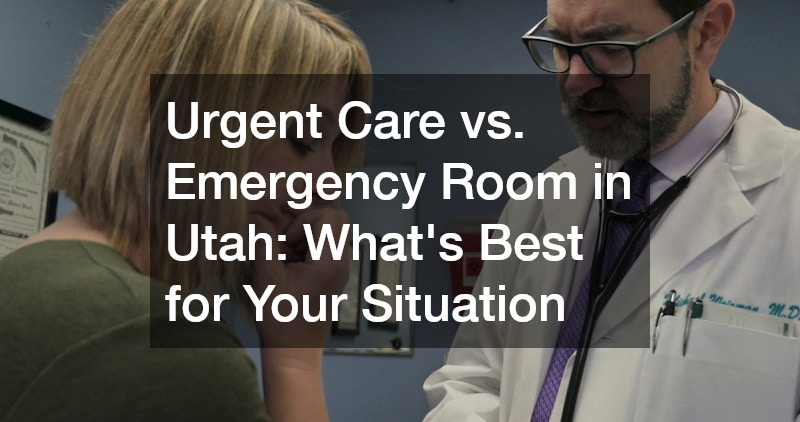Urgent Care vs. Emergency Room in Utah: What’s Best for Your Situation
An overview of healthcare choices in Utah, highlighting the differences between urgent care and emergency rooms, and why making the right choice is crucial for your medical situation.
What are the Differences Between Urgent Care and Emergency Rooms?
Services Offered
An urgent care in Utah centers are primarily designed to handle non-life-threatening medical issues that require immediate attention, such as cuts that need stitches, sprains, and mild infections. In contrast, emergency rooms are equipped to manage severe and critical conditions, including heart attacks, strokes, and major traumas that pose a threat to life or limb.
In Utah, urgent care centers often provide diagnostic services, such as X-rays and lab tests, which can offer quick results for non-emergency issues. Emergency rooms, however, possess a broader range of specialized equipment and medical expertise necessary for handling complex emergencies and can perform advanced resuscitative and surgical procedures.
The choice between these services often hinges on the severity and nature of the condition being experienced. It’s crucial to understand the limitations of urgent care and the comprehensive capabilities of emergency services to ensure appropriate treatment.
Operating Hours and Availability
Urgent care facilities typically offer extended hours, operating on evenings and weekends to accommodate urgent but non-emergent medical needs. This availability is designed to provide convenient access to healthcare without the long wait times often associated with emergency rooms.
On the other hand, emergency rooms are open 24/7, offering immediate care for severe conditions at any time of day or night. In Utah, the widespread availability of both urgent care centers and emergency rooms ensures that residents have access to the necessary level of care whenever a medical situation arises.
The key is understanding when each option is appropriate based on the timing and urgency of the medical need. Knowing the difference in operating hours and availability can make a substantial difference in receiving timely and appropriate medical attention.
When Should You Choose Urgent Care Over the Emergency Room?
Minor Injuries and Illnesses
Minor injuries and illnesses such as colds, flu, simple fractures, and sprains are ideally suited for urgent care facilities. These centers can efficiently handle such conditions with shorter wait times and less expense than emergency rooms.
In Utah, many urgent care centers provide quick, efficient assessments for these types of issues, allowing patients to receive care without the stress of long waits. This option is particularly useful for parents with young children suffering from minor but pressing symptoms that need prompt but not emergency-level care.
Choosing urgent care for non-life-threatening issues can prevent the overcrowding of emergency rooms, thereby ensuring that critical resources remain available for true emergencies. This makes urgent care a suitable choice for promptly addressing health concerns that are acute but not life-threatening.
Cost and Waiting Times
Cost-effectiveness is one of the key reasons to opt for urgent care over the emergency room, as urgent care visits are generally less expensive. For patients in Utah, understanding the financial implications of their healthcare choices is crucial, particularly for those with high-deductible insurance plans or insufficient coverage.
Additionally, wait times at urgent care centers tend to be significantly shorter, often allowing patients to see a healthcare provider within minutes rather than hours. This can be vital for those who need quick assistance without the instability of emergency room traffic, where prioritization of severe cases can lead to longer delays for less critical conditions.
By selecting urgent care for non-severe conditions, patients can benefit not only from potentially lower medical bills but also from the reduced stress and inconvenience associated with extended waits. This makes urgent care a desirable option for addressing immediate but non-critical medical needs efficiently.
How to Determine the Best Choice for Your Medical Needs?
Factors to Consider
When deciding between urgent care and the emergency room, several factors should be considered, including the severity and nature of symptoms, the time of day, and available healthcare services. Understanding the capabilities and limitations of each option can significantly impact the quality and timeliness of care received in Utah.
For instance, a sudden severe chest pain might warrant a visit to the emergency room, while a minor rash could be effectively handled at an urgent care location. Additionally, consideration of the travel distance and the specific expertise required for a medical issue can guide individuals in making an informed choice.
Choosing the right healthcare facility is crucial for ensuring the most appropriate and effective treatment, avoiding unnecessary stress, and optimizing healthcare costs. Therefore, prudence in evaluating your symptoms against the services offered is essential in deciding the best route for medical attention.
Personal and Family Health Considerations
Personal and family health history can significantly influence the choice between urgent care and emergency room visits. Individuals with chronic conditions or those with complicated medical histories may require the higher level of care and diagnostic ability found in emergency rooms.
However, for less severe issues that require immediate attention but are unlikely to mandate hospitalization, urgent care facilities can offer a faster and more economical option. In Utah, having an understanding of local healthcare options and how they align with your personal health needs is essential for making informed decisions.
Consulting with a primary healthcare provider about specific scenarios where urgent care or emergency services might be preferred can further aid in making the right choice when a medical situation arises. This personalized approach ensures that healthcare decisions are tailored to individual needs and circumstances.
Conclusion
A summary of the critical points discussed and final recommendations for making an informed decision about urgent care versus emergency room visits in Utah. Understanding the key differences in services offered, costs, and wait times between urgent care centers and emergency rooms is vital.
The ability to discern the appropriate level of care for various medical situations can enhance treatment outcomes and minimize healthcare costs. By considering the severity of the condition, personal health history, and local availability of services, individuals can make the best choices for themselves and their families.
Ultimately, knowledge is the most powerful tool in navigating healthcare options, and this information serves as a guide for making timely and appropriate healthcare choices in Utah. As informed consumers, individuals can optimize their healthcare experiences and outcomes through strategic use of urgent care and emergency room services.


